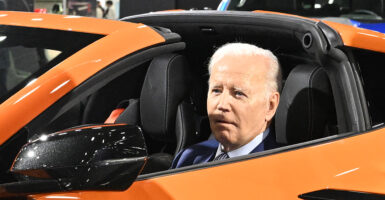Not since Prohibition has the federal government sought to ban a product as popular as the internal combustion engine.
This week, the Environmental Protection Agency released its final emissions standards rule, requiring that 70% of new vehicle sales be pure battery-powered electric or hybrids by 2032.
Prohibition was a disaster and ended 13 years after it began. If implemented, this rule to take away Americans’ choice in cars will be equally harmful.
This new rule comes at a time when auto manufacturers are dialing back on EV investments because EVs are left unsold on dealers’ lots. EV maker Fisker has stopped production. Apple is switching from building EVs to investing in artificial intelligence. Ford has paused shipments of the new F-150 Lightning pickup trucks. Mercedes and BMW no longer plan to go all-electric by 2030.
EVs are more expensive, take a long time to recharge, and lose battery range in cold weather—especially when car heating is used. The bestselling vehicle in America is the F-150 pickup truck, and the electric version costs $17,000 more than the gasoline model and does not have the towing or lugging capability of the gas-powered version.
This rule will put small businesses and farmers who need gasoline-powered pickup trucks out of business. They can’t do their jobs with electric vehicles, because recharging saps valuable time from a day. Consider landscapers who go from house to house improving people’s yards. No charging stations are nearby, and they can’t take two-hour breaks to find a charging station to recharge.
The disproportionate effect on small businesses and agriculture will result in higher prices for services and food, and upward pressures on inflation. People already follow food prices closely and complain that food costs more.
The rule will cause electricity outages because the grid, even by 2032, is unlikely to be set up for 10 million electric vehicles (70% of today’s new car sales) to charge, a number that would grow over time.
Electricity outages mean that people won’t be able to charge their EVs, and that other services and appliances that rely on electricity won’t be reliable either. That means scheduling homework and cooking around when the power comes on.
A companion power-plant rule from the EPA, not yet released in final form, would make electricity more expensive. The proposed rule would require the closure by 2040 of all power plants that did not sequester 90% of carbon emissions. In an act of stunning dishonesty, EPA does not mention its proposed power-plant rule in its final emissions standards rule.
EPA justifies its regulation on the grounds that America will have cleaner air. But EVs are not emissions free, and they impose costs on the environment that gasoline-powered cars do not share. Electrifying the U.S. vehicle fleet would have practically no effect on global temperatures by 2100, even as it raises inflation and lowers gross domestic product.
Electricity for battery-powered vehicles comes from coal and natural gas, rather than renewables. Solar, wind, and nuclear power are generally fully used for other purposes, and additional sources of energy to meet electricity demand come from fossil fuels and hydropower. Until emissions-free fuels are common enough to have a net environmental benefit, battery-powered vehicles will not reduce emissions.
Producing batteries causes emissions. Batteries are produced in China, using energy from coal-fired power plants. Producing batteries for electric vehicles uses carbon, and the longer the range of the battery, the more carbon is used. In addition, transporting batteries from China to the United States generates emissions.
Mining battery ingredients causes environmental damage. EV batteries weigh about 1,000 pounds and can reach 2,000 pounds. About 100,000 pounds of ore are needed to get the lithium, cobalt, nickel, graphite, and copper to make the batteries function. To get the 100,000 pounds of ore, it’s necessary to move 500,000 pounds of earth.
Cobalt mining in the Democratic Republic of the Congo is partly performed by children who are sent into the mines to retrieve the minerals. China, Chile, Argentina, and Australia are home to potentially damaging lithium mines.
When the battery is worn out, it must be disposed of. Some materials such as plastics, copper, aluminum, nickel, and cobalt are worth recycling. The remainder is disposed of in landfills, using a method to ensure that the lithium-ion batteries do not catch fire.
Raising the cost of transportation and meddling with Americans’ personal mobility is never wise. EVs are not suited for most of America, a large country of wide-open spaces, where inexpensive individual car transportation is a birthright.
This sweeping industrial policy will have disastrous economic and personal effects, as manufacturers waste resources investing in products that many do not want to buy, and as the cost of transportation rises.
Banning alcohol didn’t work as intended, and neither will banning the internal combustion engine.
Have an opinion about this article? To sound off, please email letters@DailySignal.com and we’ll consider publishing your edited remarks in our regular “We Hear You” feature. Remember to include the url or headline of the article plus your name and town and/or state.

























